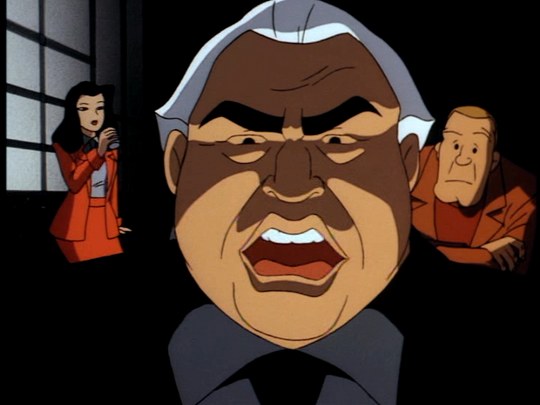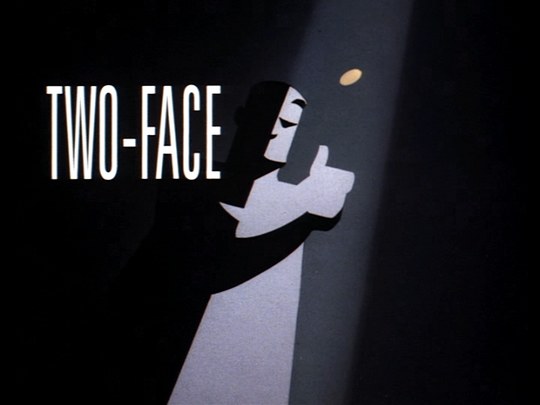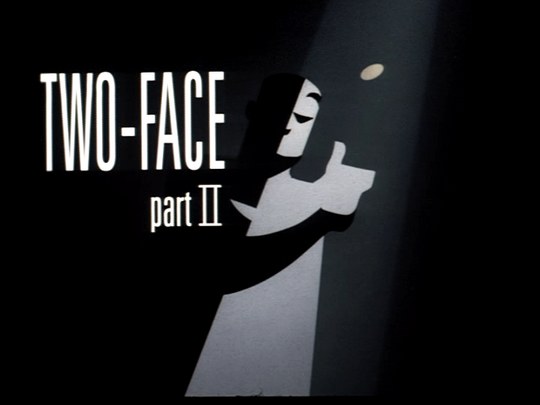“Two Face: Part 1”
Story by Alan Burnett
Teleplay by Randy Rogel
Directed by Kevin Altieri
Music by Shirley Walker
Animation Services by Tokyo Movie Shinsha Co., LTD.
Episode #010
Original Airdate – September 25th, 1992
Plot: District Attorney Harvey Dent has a dark secret: multiple personality disorder and a violent other self. Crime boss Rupert Thorne attempts to blackmail Dent, leading to an explosion, a scarring, and the creation of the supervillain Two-Face.
All right, the first two-part episode of Batman: The Animated Series, and appropriately enough, it’s the origin of Two-Face.
Two-Face is one of Batman’s oldest foes, dating back to 1942. His origin in the comics is basically the same as what’s presented here, handsome district attorney, face scarred for life by a criminal, a mental breakdown and the release of a second violent personality obsessed with duality, justice, and chance.
The Animated Series’s major addition to that story is that Harvey suffered from multiple personality disorder before the horrific scarring. I think that’s a big improvement over other versions (including The Dark Knight) where a perfectly good and sane man becomes crazy/evil in an instant. On the other hand, in the cartoon, Harvey created his other self by repressing his anger after mistakenly believing he put another boy in the hospital. That’s a little silly, a rare example of toning down the story for the child audience.
In Batman Annual #14 (1990), which had a similar twist on the Two-Face origin, Harvey’s disorder is the result of abuse at the hands of his alcoholic father. Not only does that tie into themes of corrupt authority figures and the injustice of life, it’s also more realistic, as one cause of split personalities is an abusive childhood (though maybe we shouldn’t be looking to Batman for realism).

This episode also introduces us to Rupert Thorne, who is called in every time an episode calls for “generic crime boss.” Here, he replaces both Carmine Falcone as capo dei capi of Gotham City and Salvatore Maroni as the thug personally responsible for scarring Dent. Interestingly, the writers tried to avoid stereotyping the mafia as Italian by giving Thorne a very WASP-y name (taken from a corrupt politician in the comics) but they’ve still given him a very Brando-in-The-Godfather face.

The animation is a standout in this episode, particularly the reveal of Two-Face, teasing out the horrified reactions of Batman, the doctor (in a recreation of the scene where the Joker demands to see a mirror in Burton’s Batman), and finally Harvey’s own reaction, before we finally see the monster, lit by dramatic lightning. But, in fact, we already had a glimpse of the beast that dwells in Harvey Dent, when under hypnosis he let his other side out, and, again lit by lightning, we see the villain he will become. Two-Face was always there, he was just waiting for an excuse to come out.
“Two-Face: Part 2”
Written by Randy Rogel
Directed by Kevin Altieri
Music by Shirley Walker
Animation Services by Dong Yang Animation Co., LTD.
Episode #017
Original Airdate – September 28th, 1992
Plot: Horribly scarred by Rupert Thorne, Harvey Dent has returned as the supervillain Two-Face to get his revenge, and Batman is unable to stop him. But Thorne has a plan of his own, involving Harvey’s fiancee Grace….
It’s Part 2 of the Two-Face origin story where things start to break down. From here on out, it’s another iteration of the “vengeance origin” story, but where the problem with “Nothing to Fear” was that the Scarecrow had no justification for his crimes, here Harvey is entirely justified. Thorne is a criminal who blackmailed him, scarred him, and threatens the life and security of everyone else in Gotham. And if Batman’s extra-legal crime fighting is okay, then nothing Harvey does in this episode is that bad. He robs an illegal casino, he cripples Thorne’s finances, raids Thorne’s lawyer’s office, and in the end he was planning on doing the right thing and turning over evidence to the police to put Thorne in jail for good. Thus, the question isn’t why Batman can’t stop Two-Face, it’s why is Batman even trying to stop Two-Face? In fact, why didn’t Batman do all those things before Harvey was attacked? For now, Two-Face is a better Batman than Batman.
Some of that is inevitable. Conceptually, Two-Face is a great villain because he’s a walking reminder of the time that Batman failed. Still, over the course of these two episodes, Batman is exceptionally ineffectual. Not only did he miss his best friend’s emotional problems for five years and then allow him to be violently disfigured (as he must), but then he spends six months researching multiple personality disorder while Two-Face dismantles organized crime in Gotham City. Compare that to “Christmas with the Joker,” where Batman had the Joker back in his cell in under twenty four hours. Bruce even dreams about failure (which is again his biggest fear) and the Waynes make their third appearance in eleven episodes. Enough, dead people, we get it.
The other weakness of this episode is Grace, because everything about her character is a throwback to 1942. Her only goal is to marry Harvey Dent, her only actions are to support his campaign and physical recovery, betray him, and then represent the love that will, hopefully, save Harvey. Maybe if she had been a recurring character, still fighting for Harvey even after Two-Face transitions into a more straightforward villain, she could have been interesting, but she’s never seen again. It’s a good thing the series has already introduced Montoya, because between Grace and Poison Ivy, the series has not been great with the admirable female characters.
The strength of the episode is all in the design of Two-Face, probably the most impressive translation of a character from the comics to the screen. The animators replaced the comics version of the suit (half conservative, half hideously wild) with a simple black and white design. That may have been to save on time and money, but the effect is much more striking, and makes the scarred face and hands pop more. Also it further argues that Batman just has the best dressed rogues gallery.

And again, Richard Moll delivers a superb performance over both episodes. For the character, he really does three voices, the “normal” toned Harvey Dent, the animal growl of “Big Bad Harv,” and finally Two-Face’s voice, which is a synthesis of the other two. Two-Face has the same growl as “Big Bad Harv,” but is high enough to feature sadness and longing which Big Bad Harv can’t, without actually returning to Harvey’s voice.
Two more things to note. Part 2 begins “Previously, on Batman.” It’s a small thing, but this is actually the first indication of the name of the show we are watching since there is no narration or title cards in the opening sequence.
And also, when Two-Face lingers over a photo of Grace, we can see he has a credit card issued to Two-Face. Man, they’ll give a credit card to anyone.

Steven Padnick is a freelance writer and editor. By day. You can find more of his writing and funny pictures at padnick.tumblr.com.












I quite like both parts of this. Shirley Walker’s score deserves special mention. Her Two-Face theme is built around dualities — contrapuntal melodies based on two-note phrases, played on contrasting instruments in the highest and lowest registers. And yet the ominous, creepy theme also has a more soulful, poignant variation that’s a beautiful accompaniment to the more sensitive scenes between Harvey and Grace.
Also worthy of note is Rupert Thorne’s very sexy moll Candice, voiced by Diane Michelle. If Grace was the classic ’40s good girl, Candice was very much the classic vamp. She was bad and she was drawn that way.
Rupert Thorne himself was played by perennial screen villain John Vernon. And Two-Face’s twin henchmen, Min and Max, were voiced by Mickey Dolenz of the Monkees.
A masterpiece. The best depiction of the villain in question’s origin. And an excellent example of how the baddies in the series were dimensional, nuanced, more often than not.
“Grace was not seen again”
…not exactly true. Dini brought her back a few times for The Batman Adventures comic book DC Comics published concurrent with the series.
Despite the cliches, I still think the second part of this two-parter is one of the best Batman episodes. I know we’ve been beating the dead parent horse for a while, but this episode’s nightmare is powerful. And though I agree that Grace is rather one-dimensional, the scenes between Two Face and his (former?) fiancee, I thought, were really powerful. They added an emotional depth to a villain who is otherwise, if you’ll forgive the expression, rather black and white.
I had never thought about how long it actually takes Batman to get moving in this though. That’s funny…
Rupert Thorne was actually a character created by Steven Engleheart and Marshall Rogers in Detective Comics many years before this episode. So his name was not created with avoiding ethnic sterotypes. There is the only time I can remember him being connected with Two-Faces’ origin though. Actually Engleheart wrote him as politician with gangster connections but not a gangster himself. Those stories are well worth reading and have been reprinted a few times in trade paperback.
Wasn’t John Verner also the dean in Animal House?
@5: The article does already mention that Thorne’s name was “taken from a corrupt politician in the comics.” The point was that they used that politician character as a mob boss rather than going with a more conventional Mafioso type.
And yes, John Vernon was the dean in that movie, and made something of a career out of playing villains in movies and TV, although he has a few heroic roles in his resume too (such as a major supporting character in Gene Roddenberry’s 1973 pilot movie The Questor Tapes and the voice of Dr. Strange in the ’90s Spider-Man series).
Mr Bennett,
Sorry that was my mistake. The article did mention that. Must have missed it.
Didn’t Vernon also play General Ross in the 1990s Incredible Hulk cartoon?
@7: Yes, Vernon was Thunderbolt Ross in that series.